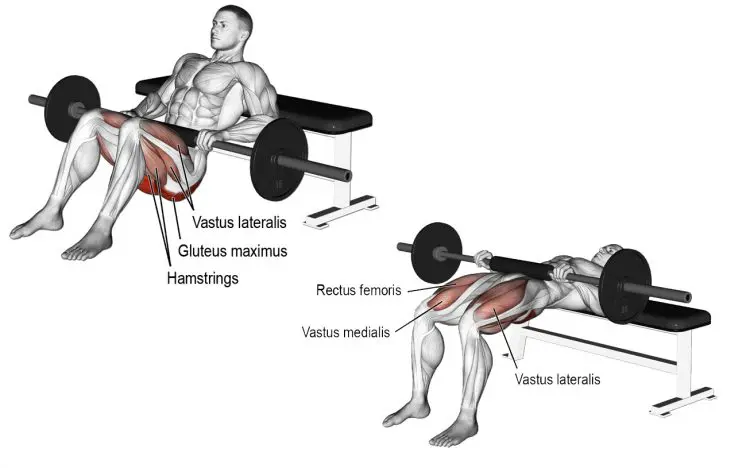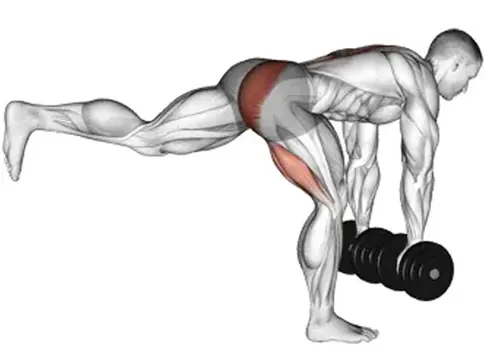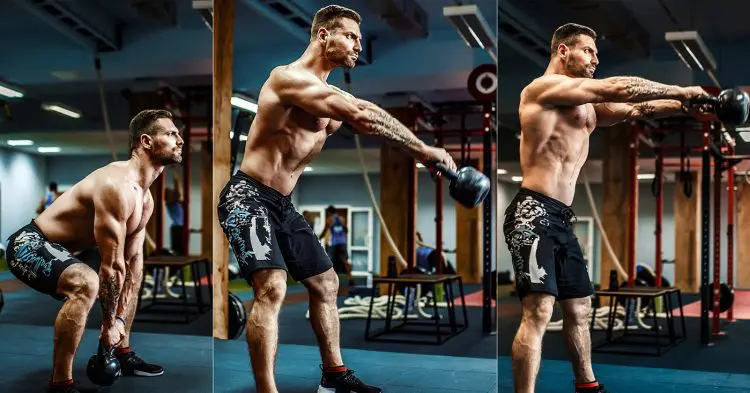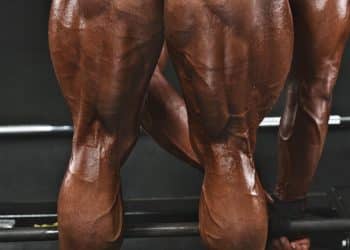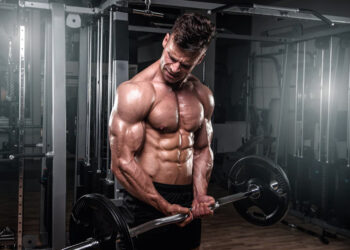Your hamstrings are a very important muscle group. Not only do well-develop hammies add a lot to the size and shape of your legs; this muscle is also strongly involved in many daily and athletic activities, such as walking, running, jumping, and kicking.
Your hamstrings are actually a group of three muscles – the biceps femoris, semimembranosus, and semitendinosus. They work together to flex your knee and extend your hip.
The most obvious (and probably the most common) way to train the hamstrings is by doing leg curls. There are several machines available for this, including seated, standing, and lying leg curls.
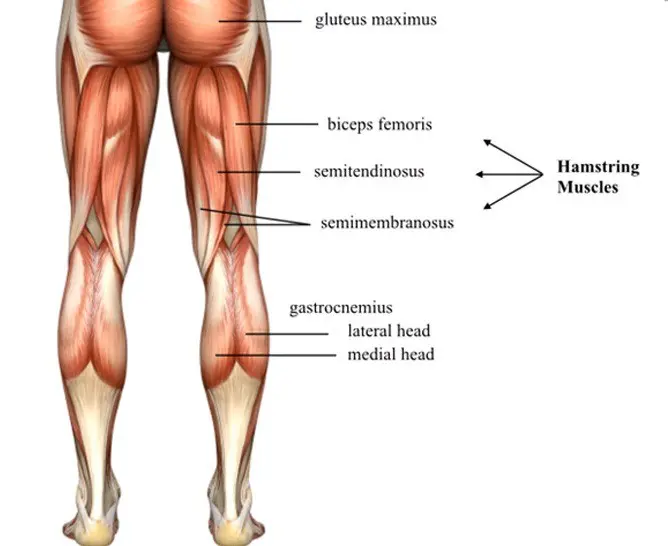
However, doing nothing but leg curls for your hamstrings can soon get old, and if you overuse an exercise, it can lose some of its potency. And, if you train in a home or garage gym, you may not even have access to a leg curl machine.
Thankfully, there are PLENTY of exercises you can use in place of leg curls to work your hamstrings. Some mirror the demands of machine leg curls but use alternative equipment, while others work your hammies using entirely different movements.
Level Up Your Fitness: Join our 💪 strong community in Fitness Volt Newsletter. Get daily inspiration, expert-backed workouts, nutrition tips, the latest in strength sports, and the support you need to reach your goals. Subscribe for free!
Here are the 15 best leg curl alternatives for stronger hamstrings. Each one is tried, tested, and certified effective!
1. Dumbbell hamstring curls
Dumbbell hamstring curls are an old-school bodybuilding exercise. Despite being a blast from the past, this simple hamstring exercise is an effective and convenient alternative to using a leg curl machine.
Get more from this exercise by doing it on a declined bench. This increases the resistance as your feet near your butt.
Learn how to do dumbbell hamstring curls here.
2. Cable hamstring curls (standing OR prone)
No leg curl machine? No problem! You can also do leg curls using an adjustable cable machine. All you need is an ankle cuff. As an added advantage, cable hamstring curls work one leg at a time, so you can make sure both legs are trained equally.
How to do it:
- Attach the cuff to your ankle, and then fix the cable to the cuff. Stand facing the machine and use your arms for balance. Brace your core.
- Bend your leg and curl your foot up toward your butt. Extend your hip slightly to increase hamstring activation, but do not hyperextend your spine.
- Lower your leg and repeat.
- You can also do this exercise lying on your front.
3. Nordic leg curls
This bodyweight hamstring exercise is one of the toughest you can do. Only attempt this exercise if you’ve got strong hamstrings. Even then, you may need to use one of the regressions mentioned below. However, if you’re looking for an intense hamstring workout, this is the move for you!
How to do it:
- Kneel on a thick exercise mat with your feet held firmly on the floor. You can put your feet under a loaded barbell or training bench or ask your training partner to hold them down. Your thighs should be vertical and your body upright. Hold your arms out in front of you.
- Using your hamstrings to control your movement, lean forward, and lower your body down to the floor. Keep your body straight. Use your arms to catch you.
- Push with your arms and pull with your hamstrings to return to the starting position.
- As you get stronger, try to rely less on your arms and do more work with your legs.
Take some of the stress off your hamstrings by holding a pole in your hands and using your arms for assistance or looping a resistance band around your chest and fixing it to an anchor behind you.
4. Stability ball leg curls
Stability ball leg curls are a great hamstring, glute, and lower back exercise. They’re more challenging than they look but, once mastered, you should still be able to progress to using just one leg at a time.
How to do it:
- Lie on your back and place your feet on your stability ball. Lift your hips, so your body forms a straight line. Brace your abs. This is your starting position.
- Bend your legs and simultaneously lift your hips. Take care not to hyperextend your spine.
- Roll the ball away from you but do not allow your hips to drop.
- That’s one rep; keep going!
5. Hamstring walkouts
This simple exercise is ideal for home workouts. Despite being very straightforward, this is still a useful and functional hamstring exercise. There is very little stress on your lumbar spine, making it a good choice for exercisers suffering from lower back pain.
How to do it:
- Lie on your back with your legs bent and feet flat. Push your hips up toward the ceiling. Brace your core.
- From this position, walk your feet away from you while keeping your glutes and hamstrings contracted. Take as many steps as you can, but do NOT let your butt or legs touch the floor.
- Walk your feet back in and repeat.
6. Heel slide leg curls
Heel slide leg curls are the perfect home hamstring exercise. All you need is a towel or slippery socks and a smooth floor. Or, if you want a more refined, high-tech workout, you can use a sliding pad – often used in group exercise classes.
How to do it:
- Lie on your back with your legs straight. Rest your heels on your towel/sliding pad. Contract your glutes and core and lift your hips a few inches off the floor.
- Bend your legs and slide your heels in toward your butt. Simultaneously push your hips up toward the ceiling.
- Extend your legs but do not let your legs or butt touch down.
- This exercise can also be done one leg at a time.
7. TRX leg curls
Suspension trainers like the TRX allow you to train virtually every muscle in your body using nothing more than your bodyweight. In addition, working out with a TRX increases core and stabilizer activation, making most suspension trainer exercises very functional.
TRX leg curls (other suspension trainers are available!) are a potent hamstring exercise that you can do almost anywhere.
How to do it:
- Set your TRX to about knee-height. Lie down on your back and put your heels in the footrests. Lift your hips off the floor, so your legs and body are straight.
- Bend your knees and simultaneously push your hips up. Pull your heels into your butt.
- Extend your legs but do not lower your hips.
8. Hip thrusts
Level Up Your Fitness: Join our 💪 strong community in Fitness Volt Newsletter. Get daily inspiration, expert-backed workouts, nutrition tips, the latest in strength sports, and the support you need to reach your goals. Subscribe for free!
Hip thrusts are usually viewed as a glute exercise. However, as well as working your butt, they also hit your hammies. After all, the hamstrings have two functions – knee flexion AND hip extension. As such, hip thrusts can also be considered a leg curl alternative.
How to do it:
- Sit on the floor with your legs bent and your upper back against a sturdy bench. Rest and hold a barbell across your hips. Brace your abs.
- Drive your feet into the floor and lift your hips until they form a straight line with your knees and shoulders. Take care NOT to hyperextend your spine.
- Lower your butt back down to the floor and repeat.
- Make this exercise harder by using just one leg at a time.
- This exercise can also be done without weight and without using the bench.
9. Donkey kicks
Donkey kicks are another glute exercise that also works your hamstrings. The key to this exercise is making sure all the movement comes from your hip and that you do not hyperextend your lumbar spine, as doing so could cause lower back pain and injury.
How to do it:
- Kneel on all-fours. Make sure your shoulders are directly over your hands, and your hips are over your knees. Brace your abs.
- Keeping your leg bent, extend your hip and push your foot up toward the ceiling. Take care not to arch your lower back.
- Lower your leg and repeat.
- Make this exercise harder by wearing ankle weights.
There is also a variation of this exercise that uses a Smith machine.
10. Romanian / stiff-legged deadlifts
Romanian and stiff-legged deadlifts are very similar exercises. Where Romanian deadlifts are done with slightly bent knees, your legs are virtually straight for stiff-legged deadlifts. Both of these exercises work your entire posterior chain, including your hamstrings, giving you a choice of two movements to do instead of or as well as leg curls.
Learn how to do these two exercises, as well as their differences, in this useful guide.
11. Single leg Romanian deadlifts
Unilateral or single-leg exercises have several advantages over two-legged or bilateral exercises. They’re generally better for developing your balance and also allow you to identify and fix left-to-right strength imbalances.
They also tend to be more functional because many daily and sporting movements happen one leg at a time. Single-leg RDLs are also a GREAT hamstring exercise.
How to do it:
- Stand with your feet together. Shift your weight over onto one leg.
- Without rounding your lower back, hinge from your hips and lean forward. Extend your non-weight-bearing leg out behind you for balance.
- Stand back up and repeat.
- If you find it hard to balance, do this exercise next to a wall and use your free hand to brace yourself. Move away from the wall as your balance improves.
- This exercise can be done with or without weights.
12. Cable pull throughs
Cable pull-throughs are similar to Romanian and stiff-legged deadlifts but, instead of using a barbell, you use a low cable machine. Because of this, they’re easy on your lower back and also keep your muscles under constant tension.
Cable pull-throughs can be done with semi-bent or straight legs as preferred. Try both and see which one you feel more in your hammies.
13. Reverse hyperextensions
Also known as reverse hypers, this exercise works your hamstrings, glutes, and lower back. It’s a popular exercise with powerlifters, who value strong hamstrings because of the role they play in deadlifts and squats. While “real” reverse hypers require a special machine, there are several ways you can replicate this exercise using readily available gym equipment.
Learn how to do reverse hypers and discover some great variations and alternatives in this in-depth guide.
14. Reverse lunges
While lunges are often seen as a quad exercise, reverse or backward lunges are much more hamstring dominant. As an added benefit, reverse lunges also tend to be easier on the knee joint than regular forward lunges. That’s good news if you suffer from knee pain.
How to do it:
- Stand tall with your feet together and your hands by your sides. Look straight ahead and not down at the floor. Brace your abs.
- Take a large step backward and bend your legs. Lower your rearmost knee down to within an inch of the floor.
- Push off your back leg and bring your feet back together.
- Do all your reps leading with the same leg or alternate legs as preferred.
- Make this exercise harder by holding weights or standing on a 4-6” raised platform and doing deficit reverse lunges.
15 Kettlebell Swings
Kettlebell swings are a potent posterior chain exercise. Done right, you’ll DEFINITELY feel this exercise in your hamstrings. Unlike most hamstring exercises, kettlebell swings are performed explosively, making them a useful power exercise. Power is your ability to generate force quickly and is an intrinsic part of most sports.
Learn how to do kettlebell swings in this guide.
Leg Curl Alternatives – Wrapping Up
If you train in a gym, or even at home, it’s very easy to fall into the trap of doing the same exercises over and over again. That’s especially true if you rely on machines like the leg curl. But, if you repeatedly use the same exercises, your body develops a sort of immunity to them, and what was once a productive workout becomes much less so.
While there is nothing inherently wrong with leg curls, they will soon get old if that’s the only hamstring exercise you ever do. Avoid training ruts and progress plateaus by changing your workout from time to time. Use these leg curl alternatives to shake up your hamstring training or any time you don’t have access to a leg curl machine.
Interested in measuring your progress? Check out our strength standards for Stiff Leg Deadlift, Lying Leg Curl, Deadlift, and more.

